Eleven Herbal Roots, Leaves, Flowers and Health Benefits
Modern medicine is effective and popular in today’s world. A lot of people, however, still turn to herbal traditional plants for healing. For some, it’s because traditional herbs and plants are always available and cost efficient. For others, it’s because they trust and believe in the traditional herbs. According to a Journal published in the National Library of Medicine, most of the modern medicines of today are derived from the natural herbal plants. Herbs have been around for a very long time. They have been used, historically, to remedy stubborn illnesses that modern medicines fail to cure.
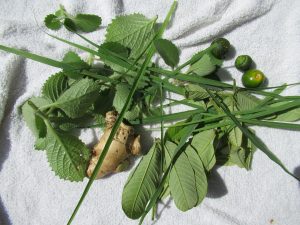
Many people still believe in traditional herbs and roots to solve their health problems. This is despite the fact that the effectiveness of synthetic drugs has been proved. Where modern medicine is not available, there are always traditional herbs. You can either take them as first aid in an emergency situation, or use them to actually solve the problem. Let’s talk about some traditional roots, leaves and flowers, their origins and their health benefits to us.
Eleven Herbal Roots, Leaves and Flowers, and their Health Benefits
1. Gingko leaves (Gingko biloba):

The gingko plant is one of the oldest homeopathic plants. It is a key herb in Chinese medicine. The leaves are used to make capsules, tablets and extracts, and can be consumed as tea when dried.
Health benefits of gingko leaves
According to a research journal published in the National Library of Medicine, the gingko leaf is perhaps best known for its ability to boost brain health. This study shows that gingko can treat patients with mild to moderate dementia, and can slow cognition decline in dementia and Alzheimer’s disease.
2. Ginger (Zingiber officinal):
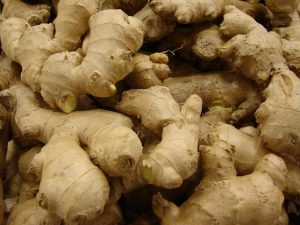
Ginger has been used worldwide, for thousands of years, in cooking and for medicinal purposes. In the culinary world, it enhances the taste and palatability of food. The tuber has a lot of health benefits, including as a remedy for nausea and stomach upsets.
Some health benefits of ginger:
- Ginger may have anti- inflammatory, antibacterial, and antiviral properties, which helps the body fight off infections
- According to a review carried out in 2018, several studies have investigated the effect of ginger on the gases that form in the intestinal tract during digestion. This research shows that enzymes in ginger can help break down and expel gas from the body and thereby relieving the body of discomfort
- Additionally, ginger may help increase movement through the digestive tract, relieving or preventing constipation
3. Purple coneflower (Echinacea purpurea):

Echinacea belongs to the daisy family and the plant is commonly grown for its decorative flowers in English gardens. For centuries, Native Americans used it as a cure for various ailments. In North America, Echinacea grow naturally in prairies and open, wooded areas.
The flowers and roots are used medicinally in teas, tinctures and tablets.
Health benefits of echinacea:
- High in antioxidants
- May boost the immune system and is often used to prevent or treat the common cold
- Studies have linked echinacea and their compounds with reduced inflammation and lower blood sugar levels
- There can be a reduction in the feelings of anxiety and stress
- Your skin might become better hydrated, even leading to fewer wrinkles
- It could ease the symptoms of eczema
4. Hops (Humulus lupulus)
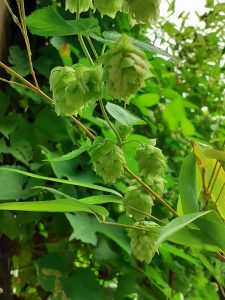
Hops were introduced to the south of England from Flanders in the fifteenth century. They are used in the beer brewing process and as a traditional medicine.
They are known mostly as an aid to relaxation and sleep, and to ease anxiety. Dried hops, in a sachet containing other calming herbs, can be placed under your pillow or hung beside your bed. Hop tea, as a drink at bedtime, can help you get a good night’s sleep. For the same purpose, hops are also used as a tincture or can be taken in capsule form.
Health benefits of hops:
- Aid digestion
- Boost the immune system
- Improve your hair and scalp
- Help to heal minor cuts or wounds
- Reduce menstrual cramps
- Ease the symptoms of menopause
Hops should not be taken by pregnant women or young children. The reason for this is because they contain chemicals called phytoestrogens, which could be harmful.
5. European Hawthorn (Crataegus monogyna)

Hawthorn is known traditionally as a natural plant to strengthen your heart. It is a native tree of the UK (except in the far north of Scotland) and across northern Europe. In Native American culture, the berries were used as a tonic for the heart and to ease gastric problems. Hawthorn is one of the oldest known medicinal plants.
It’s not just in folklore that hawthorn is valued. Scientific research has shown that it can be effective in the treatment of:
- Heart failure (easing shortness of breath and tiredness)
- Angina
- High blood pressure
- High levels of cholesterol
Hawthorn is used to enhance heart health and it contains antioxidants.
Health benefits of hawthorn:
It can:
- Boost the immune system
- Help in the treatment of allergies
- Reduce inflammation
- Improve circulation
6. Bitter leaf (Vernonia amygdalina):
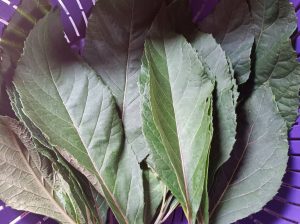
Bitter leaf (Vernonia amygdalina) has been a strong source of African traditional medicine, most especially in the west. It is also known as Ewuro in western Nigeria, Onugbu in eastern Nigeria, and Ganye mai daci in the north. Just as the name implies, this leaf is known for its extreme bitterness, and its ability to tackle many illnesses.
The leaves can be eaten raw, squeezed to extract the juice as a drink, or mixed with other medicinal flowers and herbs depending on your preference.
Health importance:
The leaf has been proven to possess antibacterial and antifungal properties and, historically, it has been used to treat many ailments. These include malaria, typhoid, diabetes, diarrhea, tuberculosis, gallstones, and kidney disease, although this cannot be scientifically proven or backed.
- Relieves Stomach Aches
Whatever the cause of the stomach ache, bitter leaf is a known traditional remedy for stomach upsets. According to a study in the Toxicology Reports Journal, the plant may provide some protection from stomach ulcers. This is because bitter leaf contains some strong antioxidants which contribute positively to gastric health.
- Enhance Fertility
According to a study in the International Journal of Reproductive Biomedicine , bitter leaf may have a positive effect on sperm quality. The high levels of vitamins and minerals in bitter leaf are positive to overall health, so will be beneficial to a couple trying to conceive.
- May Be Preventative Against Prostate Cancer
This type of cancer relatively common and it occurs most frequently amongst older men. It is essential to follow the treatment prescribed by your medical professional for successful treatment of prostate cancer. Bitter leaf, however, according to a study in the Nutrients journal, may help to prevent the disease. The same research also noted that survival rates might be improved by the plant.
7. Uziza leaf (Piper guineense):

Uziza is a medicinal spice plant of the Piper genus. It is a West African spice plant commonly known by Nigerians tribes; it called Uziza in Igbo and iyere in Yoruba. The plants that provide Uziza are vines that grow up to 20m tall. They climb up the bole of trees using roots that hook over the branches.
It is a perennial plant that is characterised by heart-shaped leaves, alternate and up to 12cm long. The leaves have a peppery taste, and are pale green in colour when fresh and a darker green when frozen or dried. They are used as a flavouring for stews. The inflorescence is a pedicel flower spike between 3 and 6cm long with a peduncle of 5mm long. Flowers are greenish yellow and arranged in a spiral along the stem.
Health benefits of uziza leaves:
- Distilled oil from uziza is used in perfume and soap making
- In some parts of Nigeria, the seeds are consumed after childbirth to assist uterine muscles to return to their original shape
- Used as an anti-asthmatic
- It can help in weight control
- Some say uziza is an aphrodisiac
- The seeds of uziza are used to relieve stomach discomfort
- It could reduce the chance of cancerous cells developing (has a high flavonoid content)
- Uziza has an anti-fungal effect
- The leaves repel mosquitoes
8. Garlic (Allium sativum)

Garlic is a species of bulbous flowering plants in the genus Allium. Members of the Allium family include onions and shallots. Onions are now used throughout the world, although native to south Asia, northeastern Iran and central Asia. Garlic was known to the ancient Egyptians where it was used both as a food and for medicinal purposes.
Fresh or crushed garlic yields the sulphur-containing compounds allicin, ajoene, diallyl polysulfides, vinyldithiins, and S–allylcysteine. It also contains enzymes, saponins, flavonoids, and Maillard reaction products, which are not sulphur-containing compounds.
Health benefits of garlic:
- Garlic can help protect against illness, including the common cold
- Due to the active compounds found in garlic, it may lower blood pressure
- Garlic helps improve cholesterol levels, which can lower the risk of heart disease
- The anti-oxidants in garlic could help in the prevention of Alzheimer’s disease and dementia
- Garlic helps detoxify heavy metals and free radicals in the body
9. Turmeric (Curcuma longa)
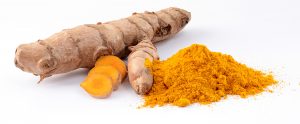
Turmeric is a common and a very popular spice and medicinal flowering plant. The rhizomes of Curcuma longa, of the ginger family, zingiberaceae, are used for cooking popular meals.
Turmeric is a native Asian plant. It has been used in Asia for centuries and is a major part of Ayurveda and Siddha medicine, traditional Chinese medicine, Unani, and the animistic rituals of Austronesian peoples.
Turmeric has a warm, bitter taste and is usually used to flavour or colour curry powders and mustards.
Health importance of turmeric
- Turmeric contains curcumin and other chemicals which could decrease swelling
- It is often used to treat pain and inflammation
- Turmeric is widely used as a herbal remedy for Osteoarthritis
- It is also used to ease hay fever, depression, high cholesterol, and itching, although there isn’t strong scientific evidence to back this up
10. Flax (Linum usitatissimum)
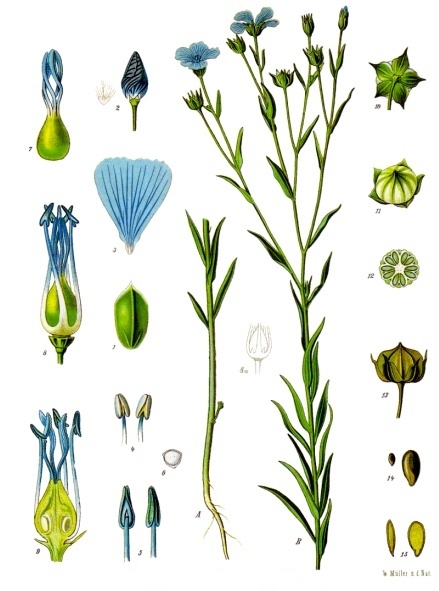
Flax is also known as linseed, and is a flowering plant. It is cultivated as a food and fibre crop and is grown in many regions of the world.
Flax is a native of middle Asia and has been used for thousands of years. It has small oil producing seeds which have been effectively used to relieve many health conditions.
In recent years, flax seed has gained popularity as a health food. This is due to its high content of Omega-3 fats, fibre and other unique plant compounds.
Health importance of flax seeds:
- It improves digestion
- Flax is said to reduce the risk of heart disease , type 2 diabetes, and cancer
- According to a research article published in the National Library of Medicine, it can reduce the level of cholesterol
- It is claimed that it could protect you against heart failure
- It could be helpful in preventing obesity
11. Noni (Morinda citrifolia)

Noni is an evergreen medicinal tree plant with large leaves and yellow fruit. It is found in the Pacific Islands, southeast Asia, Australia and India.
Noni roots, stem, fruits, bark, leaves and flowers have all been used as medicine. The fruit juice, in particular, is a common way noni has been utilized and it can be mixed with other fruits for juice too.
Health importance of Noni:
- It is high in potassium, Vitamin C, Vitamin A, and many other chemical that might help repair damaged cells in the body and activate the immune system
- Although people use noni for cancer, high blood pressure, athletic performance, to repair aging skin, diabetes and many other conditions, there as been no scientific evidence to back these claims
You may also like to read our recent article, Seven Healthy Daily Eating Habits
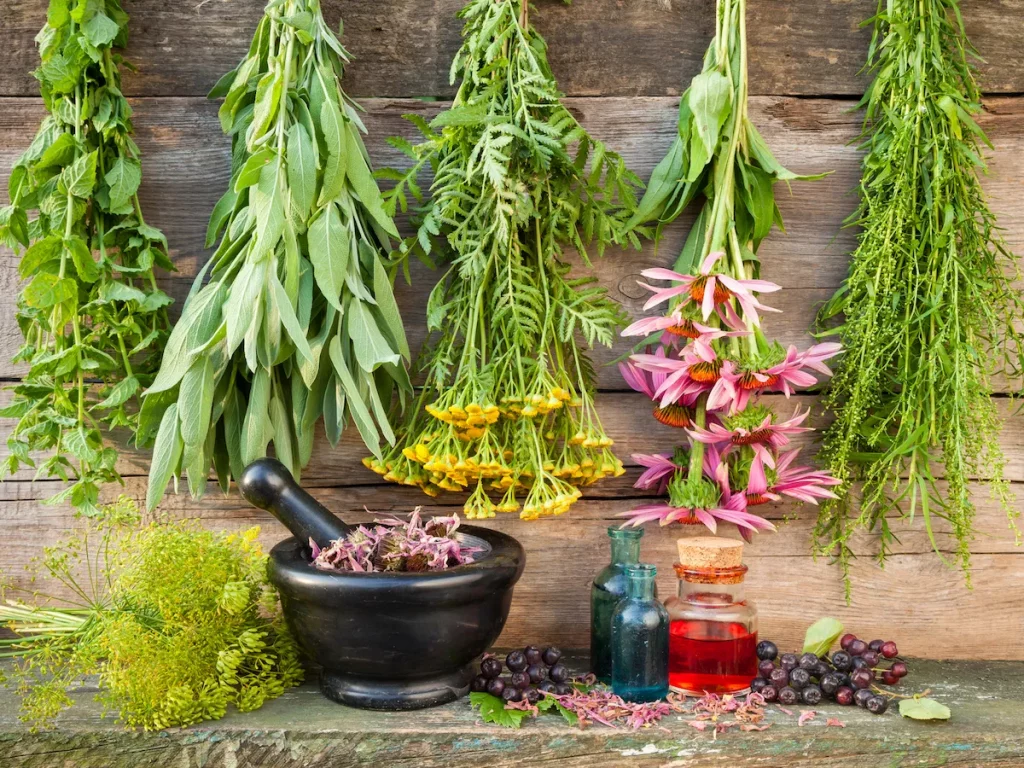
Pingback: grow your own nutrition
Pingback: Five Tips to Ease the Symptoms of a Cold - Dinachi Food & Nutrition Consultant